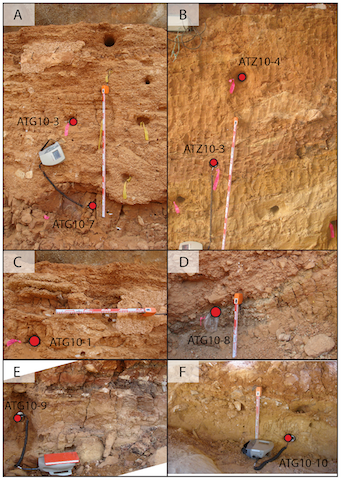Luminescence dating allows more accurate age assignment of Sierra de Atapuerca samples.
̀ưand Dr Martina Demuro have published a of the Atapuerca palaeoanthropological sites which builds on the recent Science paper from Sima de los Huesos and focuses on resolving the age of the iconic Acheulian lithic industry at the neighbouring site of GalerĂa Complex.
A series of novel 'extended-range' luminescence dating approaches have been used to provide replicate ages on quartz and feldspar extracts, enabling researchers to push the boundaries of conventional luminescence dating into the .
[caption id="attachment_7315" align="aligncenter" width="341" caption="Photos showing the location of the luminescence dating samples and the types of deposits investigated at GalerĂa. (Credit: PLOS ONE)"] [/caption]
[/caption]
Main findings of the study:
The paper was entitled "New Luminescence Ages for the GalerĂa Complex Archaeological Site: Resolving Chronological Uncertainties on the Acheulean Record of the Sierra de Atapuerca, Northern Spain" and̀ưpublished in the open access journal .
You can read more about skulls dug up from thèưThèưSima de los Huesos̀ư(pit of bones) and the findings that were uncovered in our blog post from earlier this year: .
A series of novel 'extended-range' luminescence dating approaches have been used to provide replicate ages on quartz and feldspar extracts, enabling researchers to push the boundaries of conventional luminescence dating into the .
[caption id="attachment_7315" align="aligncenter" width="341" caption="Photos showing the location of the luminescence dating samples and the types of deposits investigated at GalerĂa. (Credit: PLOS ONE)"]
 [/caption]
[/caption]Main findings of the study:
- The oldest Acheulean lithic records at GalerĂa have an age of ~313 ka, and are much younger than previously thought (~500 ka). The uppermost section of the archaeological sequence, which contains more carefully configured Acheulean artefacts, has an age of ~240 ka.
- The results corroborate other ages obtained by ESR / U-series on teeth, and indicate that previous thermoluminescence (TL) chronologies for the sequence, which ranged from ~400 to ~500 ka, were an overestimate.
- With these new results researchers can place the Middle Pleistocene archaeological records of Atapuerca within a firmer chronological scheme and reconstruct more detailed patterns of human occupation in the area. Importantly, the new chronologies indicate that the human remains of Sima de los Huesos, located in the same karst system, are 100 ka older than the Acheulean artefacts from GalerĂa Complex. The occupation of these two sites did not overlap, as previously postulated.
- The new chronologies confirm that the Acheulean Early Palaeolithic record at Atapuerca temporally overlaps with Middle Palaeolithic industries (Levallois) reported from other sites in Western Europe. This raises important questions about spatial and temporal complexities in the evolution of lithic technologies in Europe and potentially challenges the traditional view of a linear Early to Middle Palaeolithic transition in the Iberian Peninsula.
The paper was entitled "New Luminescence Ages for the GalerĂa Complex Archaeological Site: Resolving Chronological Uncertainties on the Acheulean Record of the Sierra de Atapuerca, Northern Spain" and̀ưpublished in the open access journal .
You can read more about skulls dug up from thèưThèưSima de los Huesos̀ư(pit of bones) and the findings that were uncovered in our blog post from earlier this year: .

Newsletter & social media
Join us for a sensational mix of news, events and research at the Environment Institute. Find out about̀ưnew initiatives and̀ưshare with your friends what's happening.
̀ừừư
